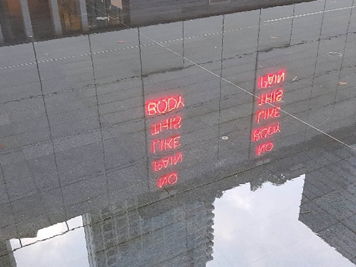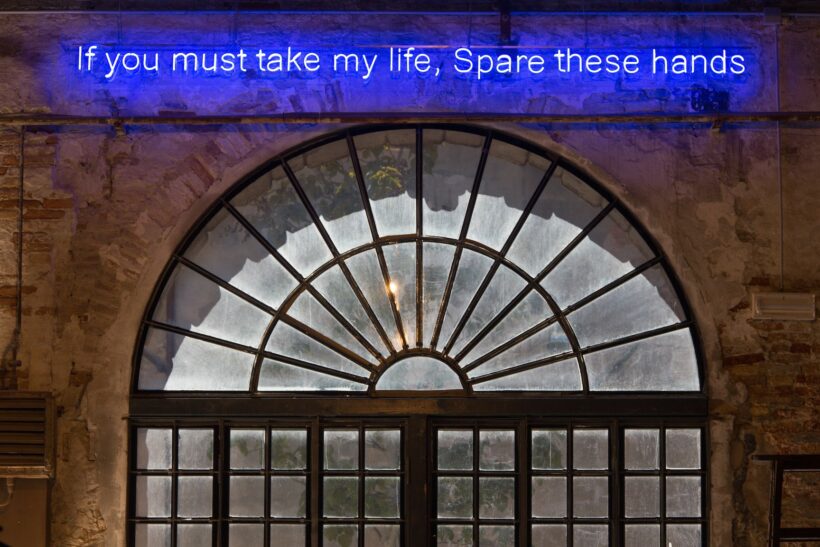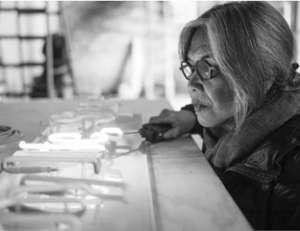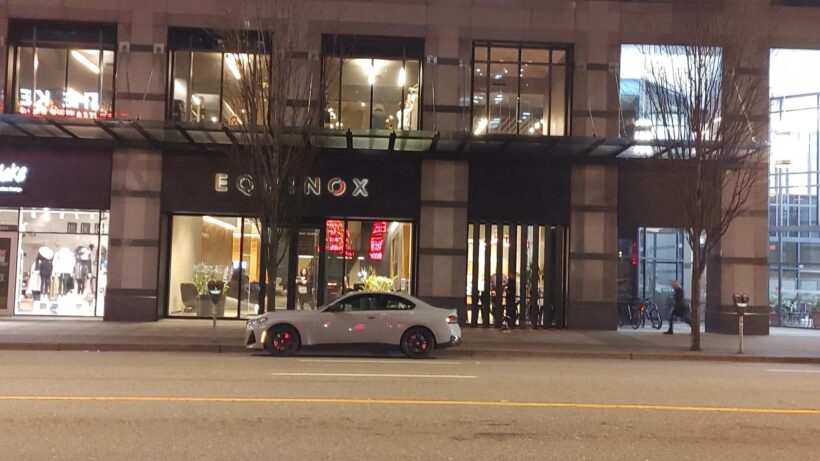Sandwiched with the skyscraper Shangri-La Hotel and the less imposing The Keg betwixt Thurlow and Bute along West Georgia Streets downtown, Lani Maestro’s installation art, sculpted glass texts and neon light that reads on two columns, No Pain Like This Body, No Body Like This Pain, bites, delights and intrigues. Sharply.
by Maria Veronica G. Caparas
It is no surprise that the Vancouver Art Gallery, through the City of Vancouver’s Public Art Program, honors Maestro’s installation sculpture with a space that juxtaposes the artist’s initial inspiration of Vancouver’s Downtown Eastside neighborhood with that of Westbank, Peterson Investment Group, and Shangri-La’s. Maestro walks us through her site-specific work which renders the viewer’s experience as the key to communing with her art.
Maestro’s choice of ruby red (cf. Latin ruber, red) neon for this particular sculpted glass text speaks to her art’s intent, and within spatial protocols and textual specs offsite. The ruby red neon-lit-glass text at night reflects texts on the waters below as well as on the glass walls of the Shangri-la and those of the offices across the text wall and yes, the wall over which “The Keg” rests.



(Photos courtesy of Erie Maestro)
Offsite daytime, Maestro’s neon captures the reflection of the infrastructures that seem to mar the purity of cloudless skies. Without meaning to, perhaps, Maestro presents to the viewers the structural barriers that upend the discovery of the sculpted glass text that contains the stories of Vancouver Downtown Eastside populace’s response to poverty and injustice. In life, these stories get eclipsed or sadly, silenced and even dismissed. Not for Maestro. Not for Maestro’s art.


Photos courtesy of MVGC
The ruby red color is described by Maestro as “an expensive color in neon, mostly fabricated in Italy”. As a viewer of No Pain Like This Body, ruby red connotes passion, protection, power and strength – the very traits that Maestro possesses as an artist par excellence and that she projects to spectators – motorists, commuters and pedestrians alike, for this offsite art.
Back in 2010, Maestro’s installation of No Pain Like This Body exhibited inside and outside of Canada gave the viewers the luxury of confronting the texts face-to-face, allowing tactile and ocular level interactions. Given the proximity of the text to the viewers, the neon seems to give museum and gallery enthusiasts more avenues of interacting with their own experiences. Does the ruby red-neon-lit sculpted glass text evoke subtle remembrances of human pain and the multiple shades of one color? Does the text become the body that turns into a willing or unwilling representation of passion and power?

Photo courtesy of Maestro biennale exhibit 2017
To the question of whether she has been commissioned to create art using neon and if she has done it for a while, Maestro wrote, “the use of text with neon was always my choice, and integrated into a larger installation… almost all works are ‘commissioned’ for particular places or spaces. Often, I am invited to see and choose a space or a site. I produce work addressing the chosen milieu, i.e., abandoned factories, prisons, deconsecrated churches, and traditional homes/architecture. They begin conceptually… and often, I consider the history of a place, or its past, or current inhabitants, its ‘energy’. I like to start from nothing, not knowing anything… and so I have to be present and absorb a place…. it is almost imperative that I am physically present in the space which is why I travel a lot for my work. It is the conversation that I have with a place that is important. Also, to be aware not to merely ‘colonize’ a space as if it was just a ‘container’ for artworks…I do the same for a gallery. I do believe that any space has its own subjectivity. ”
“There is another work that I made after No Pain…it is called “these hands”. It was made originally in French and was situated at the entrance of a closed-down jewellery factory in the south of France. The arrival of globalization had forced many industries to rely on cheap labor in the third world and caused the death of local livelihoods in the French countryside. The neon reads: “If you must take my life, spare these hands”. This English version was re-fabricated for the Venice Biennale exhibition in Italy. Perhaps, this sentiment is also appropriate in the context of certain struggles within artistic production and so, it suited the Venice site. “

Installation view of Maestro’s work, Philippines Pavilion, 57th Venice Biennale, Italy, 2017.
Who is Lani Maestro?

Photo courtesy of Lani Maestro
Lani Maestro, born and raised in the Philippines, completed a Bachelor of Fine Arts degree at the University of the Philippines (UP) in the late 1970s at the height of the infamous Martial Rule. That was the time when UP students and other sectors of society took to the streets and braced themselves against the military’s barbed wire, rifles, truncheons, and tear gas. A student who goes through the walls of UP, then and now, knows what the University represents: social consciousness and service to the people.
Maestro’s UP education and vicarious learning on the streets coupled with artist residencies at the Banff Centre for the Arts in Alberta in the 1980s nailed Lani’s resolve to espouse the art that she envisions: borderless, emancipatory, empowering, interactive, liberating, strengthening. Throughout her early years in the Philippines and in Canada, Lani explored her art media that cut across color, country, ethnicity, gender, and race. Maestro did her MFA at the Nova Scotia College of Art and Design in Halifax. In 2018, NSCAD University gave Maestro an honorary doctorate, honoris causa, in recognition of her outstanding art practice. She taught at the Nova Scotia College of Art & Design, at the University of Lethbridge in Alberta, and at Concordia University in Quebec.
Maestro has received the recognition and respect of an international art community having represented Canada in numerous important international art exhibitions. At the 57th Venice Biennale in Italy, Lani Maestro co-represented the Philippines, and did both her countries proud – the countries that mark art as key to honoring and respecting humanity.
Maestro’s VAG Offsite work which is on exhibit until April 9, 2023, is guest-curated by Makiko Hara and organized by the Vancouver Art Gallery on behalf of the City of Vancouver’s Public Art Program. This exhibition is an initiative of the Vancouver Art Gallery’s Institute of Asian Art.
About the Writer:

Maria Veronica G. Caparas is an alumna of the University of the Philippines, a Philippine Collegian writer, a member of the College Editors Guild of the Philippines in the 1980s, and a freelance journalist. An international consultant, researcher, professor, and scholar, Maria Veronica G. Caparas has taught leadership, management communication, research, social science, and speech communication courses to business and development managers, executives, graduate students, and university students in various institutions, including the University of Alberta, Canada, the Asian Institute of Management, the University of the Philippines (as Full Professor), Ateneo de Manila University, Philippines, and Maryknoll College, Philippines (Professorial Lecturer). A visiting research fellow at the University of Bristol, Veronica has won a number of awards for excellence in research and teaching, notably the Bacchus Graduate Research Prize for International Education, the Social Sciences and Humanities Research Council of Canada – Armand Joseph Bombardier, the Presidential Prize of Distinction, the Michael Smith Foreign Study Supplement, the GRA Rice Scholarship in Communications, and the General Education Professorial Chair, among others.










